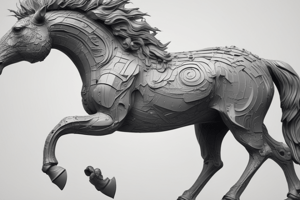Podcast
Questions and Answers
A uniformly layered form is also known as a bob.
A uniformly layered form is also known as a bob.
False (B)
The shape of a uniformly layered form is round.
The shape of a uniformly layered form is round.
True (A)
Uniformly layered forms have no discernable ________.
Uniformly layered forms have no discernable ________.
weight
The texture of the uniformly layered form is totally ______________.
The texture of the uniformly layered form is totally ______________.
Partings for a uniformly layered form are horizontal, vertical or _____________.
Partings for a uniformly layered form are horizontal, vertical or _____________.
The distribution used for uniformly layered form is ________________________.
The distribution used for uniformly layered form is ________________________.
Avoid inconsistent projection, since that will lead to ___________ ____________.
Avoid inconsistent projection, since that will lead to ___________ ____________.
To adapt to flatter areas of the head, position your fingers ____________________ to the head.
To adapt to flatter areas of the head, position your fingers ____________________ to the head.
An option to create uniformly layered form is to sculpt the design line in natural __________.
An option to create uniformly layered form is to sculpt the design line in natural __________.
A special technique used when sculpting uniform layers on curly texture is called ___________ _____________.
A special technique used when sculpting uniform layers on curly texture is called ___________ _____________.
Which of the following describes the lengths of the uniformly layered form?
Which of the following describes the lengths of the uniformly layered form?
Which parting pattern creates the appearance of weight in a uniformly layered form?
Which parting pattern creates the appearance of weight in a uniformly layered form?
What type of distribution is used to sculpt uniform lengths?
What type of distribution is used to sculpt uniform lengths?
Which projection angle is used to sculpt the uniformly layered form?
Which projection angle is used to sculpt the uniformly layered form?
What can be done while sculpting shorter uniform lengths to maintain equal distance from the head?
What can be done while sculpting shorter uniform lengths to maintain equal distance from the head?
What type of design line is used to sculpt uniform lengths?
What type of design line is used to sculpt uniform lengths?
When sculpting uniformly layered lengths, the design line should remain:
When sculpting uniformly layered lengths, the design line should remain:
Which of the following can be done to establish more weight along the perimeter hairline when sculpting a uniformly layered form?
Which of the following can be done to establish more weight along the perimeter hairline when sculpting a uniformly layered form?
Which of the following statements is true when sculpting uniformly layered forms with tighter curl patterns?
Which of the following statements is true when sculpting uniformly layered forms with tighter curl patterns?
An advanced technique used when sculpting uniform layers on tightly curled hair is called:
An advanced technique used when sculpting uniform layers on tightly curled hair is called:
Flashcards are hidden until you start studying
Study Notes
Uniformly Layered Forms Overview
- Known as a "bob", a uniformly layered form is characterized by its distinct structure and layout.
- The form is round in shape, providing a balanced appearance.
Characteristics of Uniformly Layered Forms
- There is no discernible weight, contributing to a light and airy feel.
- The texture is fully activated, enhancing movement and style.
Sculpting Techniques and Guidelines
- Partings can be horizontal, vertical, or pivotal, affecting the overall look.
- Perpendicular distribution is essential for achieving even lengths.
- To avoid uneven lengths, consistent projection is crucial during the sculpting process.
Finger Positioning and Adaptation
- When working on flatter areas of the head, fingers should be positioned nonparallel for accurate sculpting.
- Sculpting the design line in natural fall helps adapt the hairstyle to the head shape.
Special Techniques
- Freeform sculpting is recommended for curly textures to create uniform layers effectively.
- A mobile design line facilitates the creation of uniform lengths by allowing flexibility during sculpting.
Projection and Length
- A projection angle of 90° is used while sculpting to maintain consistency in lengths.
- Extending the little finger and resting it on the scalp aids in keeping an equal distance from the head during the process.
Establishing Weight and Appearance
- Sculpting larger perimeter sections in natural fall first can add weight along the perimeter hairline.
- Lengths of uniformly layered forms remain equal, providing a uniform appearance.
Adjustments for Curl Patterns
- Hair with tighter curl patterns may appear shorter after sculpting, requiring careful consideration during the process.
- Advanced techniques like freeform sculpting are useful specifically for dense, curly hair textures.
Studying That Suits You
Use AI to generate personalized quizzes and flashcards to suit your learning preferences.




